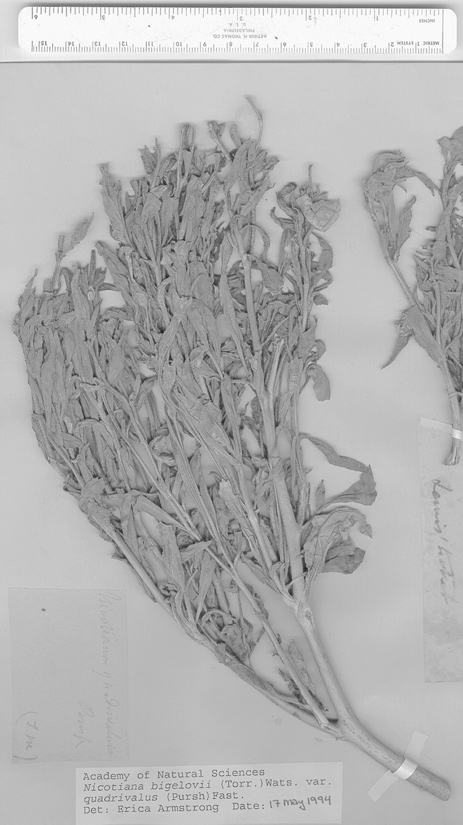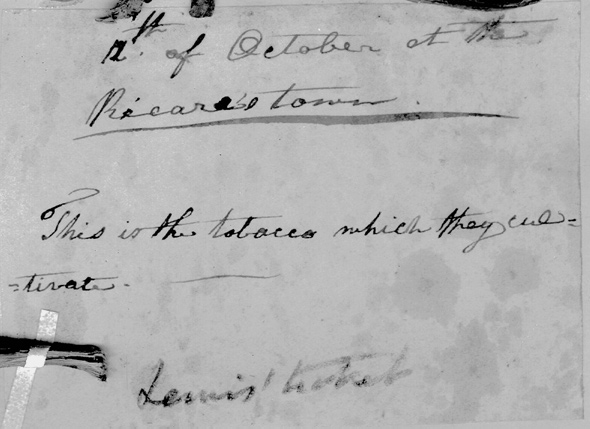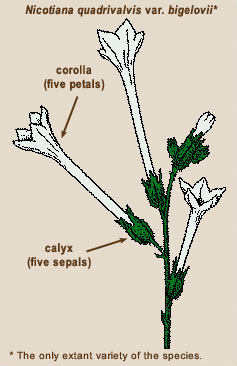American Varieties
The term “Nicotiana” was coined by Caspar Baulin in 1621 to honor Jean Nicot (1530-1600), the French ambassador to Portugal, who introduced tobacco at the French court in 1561. The name was formally adopted by the Swedish naturalist Carl Linnaeus in 1753, at which time four species were known. Today, the genus contains some 60 species, these being found in the New World, on scattered Pacific Islands, and in Australia. When Frederick Pursh proposed Nicotiana quadrivalvis in 1813, all known species had a 2-valved seed capsule so that this species with a 4-valved capsule was conspicuously different. Most of the western American species of the genus have four valves.
In the Journals
The scientific name was given by Frederick Pursh in his Flora Americae Septentrionalis in North American Plants, published in 1814.
A portion of the original label, written by Lewis on the specimen blotter. It reads: “. . . 12th of October at the Ricares town. This is the tobacco which they cultivate.”[1]According to Clark (12 October 1804), these specimens and seeds were given them by Pocasse (“Hay”), chief of the “1st village” (Rhtarahe) of the Arikaras, in South Dakota near … Continue reading
Lewis mentioned two species of tobacco, possibly Nicotiana quadrivalvis and N. rustica—a Mexican species called Aztec tobacco—that the Arikaras cultivated “for the purpose of smoking in which way they use it altogether, as they neither snuff nor chew.”[2]Lewis’s natural history notes, Thwaites, Moulton, loc. cit. In Lewis’s time, Nicotiana quadrivalvis Pursh and N. rustica were cultivars among Indians on the Great Plains, having long … Continue reading He briefly described the first, or “larger species,” without mentioning the four valves, and then detailed the Indians’ method of cultivation:
They prepare hills at the distance of about 2-1/2 feet from each other, and leavel the top nearly leaving it somewhat convex. In those hills they sew the seed as early in the spring as the climate will permit them to prepare the earth, say latter end of April. They keep the hills clear of weeds and grass by plucking it from among the stalks of tobacco with their fingers and sometimes allso thin the stalks of tobacco by plucking up the weaker stalks, tho they leave many stalks to grow on each hill.
The process was of particular interest to Lewis, himself a tobacco grower:
When the tobacco begins to form it’s seed poods [pods] it is then ready for the knife, when a great portion from each hill is cut and hung on sticks untill it is nearly dry, when they form them into carrots of the thickness of a mans arm, role them closely with willow bark, and hang them in the smoke of their lodges to dry. . . . They esteem much more the corroller [corolla, consisting of the petals] dryed for the purpose of smoking, and for this purpose leave some plant[s] more widely seperated from each other, in which situation they produce a greater abundance of flowers & seed. They begin to blume in the month of [blank] and continue untill the first frost. During the full blume of the flower they pluck the corrollar together with the flower and discarding the latter, suffer the former to dry in the shade. When perfectly dryed it resembles at first view the green tea, and in that state it is smoked by the indians.
Lewis found the Arikaras’ tobacco “very plesent,” adding, “it does not affect the nerves in the same manner that the tobacco cultivated in the U’S. dose.” Though obviously aware that the tobacco grown in his own part of the country had a unique property, he couldn’t have identified it, for it was not until 1828 that scientists identified the alkaloid component of N. tabacum as what we call nicotine. Most varieties now used in the manufacture of smokables and chewables have a nicotine content of a little over eight percent, based on the dry weight of cured leaves. Research has indicated that N. quadrivalvis had a nicotine content of approximately 0.16 percent. However, N. rustica, which may have been used less frequently, had a varying nicotine content that ranged from 2.88 percent up to 8.26 percent.[3]Joseph C. Winter, Tobacco Use by Native North Americans: Sacred Smoke and Silent Killer (Norman: University of Oklahoma Press, 2000), 183. Other members of the family Solanaceae—potato or … Continue reading
Corolla and Calyx
Nicotiana quadrivalvis var. bigelovii[4]Based on Arthur Cronquist, Arthur H. Holmgren, Noel H. Holmgren, James L. Reveal and Patricia K. Holmgren, Intermountain Flora: Vascular Plants of the Intermountain West, U.S.A. (5 vols., New York … Continue reading
Based on Cronquist, Reveal et al, Intermounatin Flora, Vol. 4, 73.
Although Lewis wrote, “they pluck the corrollar together with the flower and discarding the latter, suffer the former to dry in the shade,” undoubtedly he meant to say the Indians picked the calyx and the corrolla, and discarded the latter. Only the calyx would dry into something resembling green tea. The corolla of this plant is up to 1.5 inches (4–5 cm) long; the calyx is from 14 to 20 cm long.
The bulky specimen pictured on the preceding page, was not pressed, but is a single stalk of tobacco leaves, without calices (plural for calyx) and corollas, that probably had already been hung in the smoke of a lodge to dry before Lewis acquired it. Corolla is Latin for “garland” and calyx is Latin for “cup.” Petal is Latin for “leaf,” and sepal means “cover.” Sepals usually are green, petals are not.
Notes
| ↑1 | According to Clark (12 October 1804), these specimens and seeds were given them by Pocasse (“Hay”), chief of the “1st village” (Rhtarahe) of the Arikaras, in South Dakota near the North Dakota state line, a few miles above the Grand River. |
|---|---|
| ↑2 | Lewis’s natural history notes, Thwaites, Moulton, loc. cit. In Lewis’s time, Nicotiana quadrivalvis Pursh and N. rustica were cultivars among Indians on the Great Plains, having long since been imported for the purpose of cultivation from the vicinity of eastern California. They are now extinct, and in fact N. quadrivalvis is the only plant Lewis discovered that has not been found since then, even in in its original habitat. James L. Reveal, Gary e. Moulton, and Alfred E. Schuyler, “The Lewis and Clark collections of vascular plants: Names, types, and comments,” Proceedings of the Academy of Natural Sciences of Philadlphia, Vol. 149 (29 January 1999), 33–34. |
| ↑3 | Joseph C. Winter, Tobacco Use by Native North Americans: Sacred Smoke and Silent Killer (Norman: University of Oklahoma Press, 2000), 183. Other members of the family Solanaceae—potato or nightshade—contain nicotine, the more notable being Atropa bella-donna (bella-donna of Europe), Datura stramonium (jimsonweed, a plant of the Americas), and Solanum tuberosum (Irish potato, an Old World species). Small amounts are reported in such plants as celery, papaya, coca, English walnut and even non-flowering plants like the club-moss Lycopodium clavatum (running ground-moss) found in the eastern United States and in the Pacific Northwest. The amount of nicotine in Nicotiana tabacum is many times greater than in any of these. |
| ↑4 | Based on Arthur Cronquist, Arthur H. Holmgren, Noel H. Holmgren, James L. Reveal and Patricia K. Holmgren, Intermountain Flora: Vascular Plants of the Intermountain West, U.S.A. (5 vols., New York Botanical Garden, 1984), 4:73. |
Experience the Lewis and Clark Trail
The Lewis and Clark Trail Experience—our sister site at lewisandclark.travel—connects the world to people and places on the Lewis and Clark Trail.
Discover More
- The Lewis and Clark Expedition: Day by Day by Gary E. Moulton (University of Nebraska Press, 2018). The story in prose, 14 May 1804–23 September 1806.
- The Lewis and Clark Journals: An American Epic of Discovery (abridged) by Gary E. Moulton (University of Nebraska Press, 2003). Selected journal excerpts, 14 May 1804–23 September 1806.
- The Lewis and Clark Journals. by Gary E. Moulton (University of Nebraska Press, 1983–2001). The complete story in 13 volumes.




